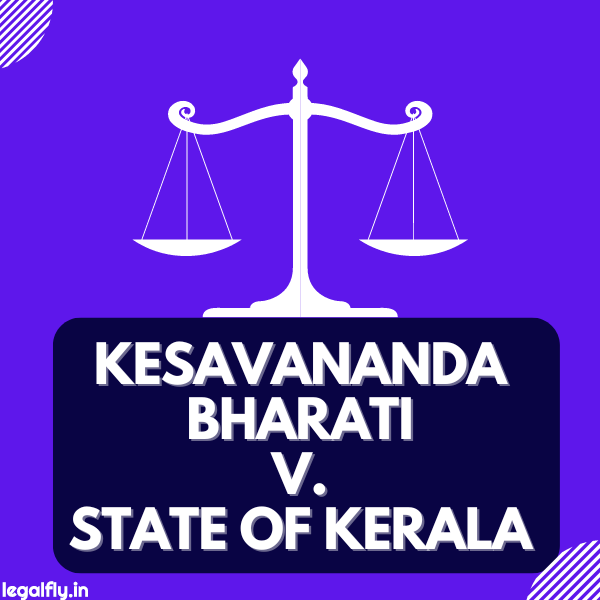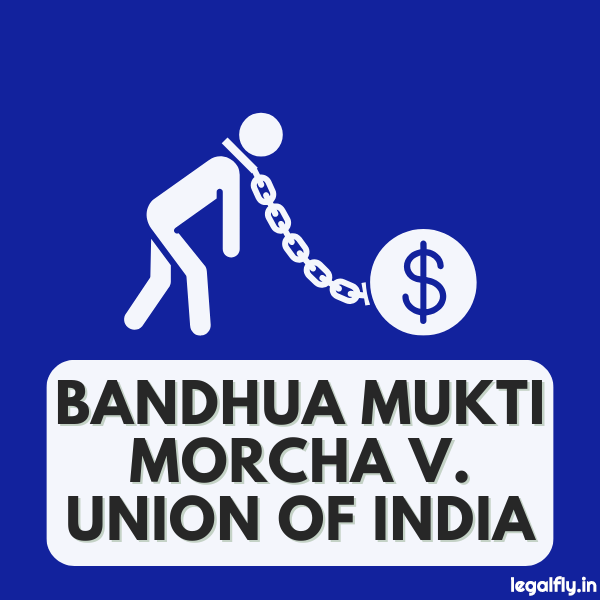Case Name: Kesavananda Bharati v. State of Kerala Court: Supreme Court of India Year: 1973 Citation: (1973) 4 SCC 225
Table of Contents
Introduction to Kesavananda Bharati Case
Kesavananda Bharati v. State of Kerala is considered one of the most significant cases in Indian constitutional law history. It established the basic structure doctrine, which limits Parliament’s power to amend the Constitution.
The case was filed in 1970 by Kesavananda Bharati, head of a Hindu mutt in Kerala. He challenged the validity of the 25th Amendment, which restricted the right to property. The 29th Amendment also curtailed the power of courts to examine constitutional amendments. Bharati argued these amendments violated fundamental rights.

The case came amid a clash between the judiciary and government over who had final authority in interpreting the Constitution. Earlier rulings had upheld Parliament’s unlimited amending powers. This case marked a turning point by limiting those powers for the first time.
The Constitutional Amendments and the Challenge
In the early 1970s, the government of India under Prime Minister Indira Gandhi passed several controversial constitutional amendments aimed at reducing the power of the Supreme Court and High Courts to rule on certain matters.
These included the 24th Amendment in 1971, which affirmed the power of Parliament to amend any part of the Constitution. The 25th Amendment in 1972 reduced the right to property as a fundamental right and made it only a legal right. Finally, the 29th Amendment in 1972 put the election of the Prime Minister beyond judicial review.
These amendments prompted Kesavananda Bharati, a Hindu religious leader, to file a petition challenging their validity. He argued that they violated the Constitution’s basic structure and essential features. According to Bharati, fundamental rights could not be abrogated, and the Supreme Court must retain judicial review over constitutional amendments.
The case thus centered on where to draw the line between Parliament’s amending powers and the core basic structure of the Constitution that could not be altered. This set the stage for the landmark ruling that would follow.
The Supreme Court’s Verdict and Its Implications
The Kesavananda Bharati case verdict was delivered by a 13-judge bench, the largest ever constituted bench in the Supreme Court. By a thin 7–6 majority, the bench struck down the 29th Amendment but upheld the 24th and 25th Amendments with some modifications. However, the significant ruling that emerged was the establishment of the basic structure doctrine.
The majority opinion held that while Parliament has wide powers to amend the Constitution, it did not have the power to destroy or abrogate its basic structure or framework. This ruling placed substantive limits on the amending powers of Parliament under Article 368 and implied that certain fundamental features of the Constitution cannot be altered.
The minority opinion differed, stating that Parliament’s amending powers under Article 368 were plenary and could not be restricted by reading implicit limitations. However, the majority view prevailed.
The verdict had far-reaching implications for the future by imposing restrictions on Parliament’s power to amend the Constitution. This upheld the supremacy of the Constitution and prevented arbitrary state action to destroy its basic features, thus protecting civil liberties. The verdict also instituted the Supreme Court as the interpreter of the Constitution and the arbiter of amendment validity.
Analyzing the Basic Structure Doctrine
The basic structure doctrine refers to the principle that certain fundamental features of the Indian Constitution cannot be altered or destroyed through amendments by Parliament. The theory rests on the premise that while Parliament has wide powers to amend the Constitution under Article 368, those powers are not unlimited. Certain foundational constitutional values constitute the ‘basic structure’ of the document, which places substantive limits on the amending power.

The basic features of the basic structure were first elucidated in the landmark Kesavananda Bharati case in 1973. While the Supreme Court justices delivered several separate judgments, the majority consensus identified features like the supremacy of the Constitution, separation of powers, federalism, secularism, sovereign democratic republic, and the judicial review power of the Supreme Court as forming the unamendable basic structure. Any constitutional amendment that violates this basic structure shall be considered unconstitutional and void.
This doctrine significantly curtails Parliament’s amending powers under Article 368. Any future constitutional amendment that abrogates or abridges the essential features of the basic structure will be struck down as unconstitutional. For instance, amendments that destroy judicial independence by giving unchecked appointment powers to the executive or undermining secularism, equality, and freedom can potentially be overruled, citing a violation of basic structure. By preserving certain fundamental principles, the doctrine aims to safeguard Indian democracy and the Constitution’s supremacy.
Key Arguments Presented by Both Sides
Arguments by the Petitioner
Kesavananda Bharati, a religious leader and landowner, argued that the Kerala Land Reforms Act violated his fundamental right to manage religiously owned property under Article 26 of the Constitution. He contended that the 29th Amendment prevented judicial review of laws violating fundamental rights. His lead counsel, Nani Palkhivala, argued that Parliament could amend the Constitution but not its basic structure.
Defence by the State of Kerala
The State of Kerala argued that Parliament had the unlimited power to amend any part of the Constitution under Article 368. The amendments did not alter the basic structure or violate fundamental rights. The government had the power to enact land reform laws for equitable distribution under Article 39.
The Role of the Largest Bench in Indian Judicial History
The Kesavananda Bharati case holds the distinction of being heard by the largest-ever Constitutional Bench of 13 Judges in the history of the Supreme Court of India. This unprecedentedly large bench was constituted since the case involved substantial questions of law regarding the interpretation of the Constitution.
Significance of the 13-Judge Bench
The 13-judge bench assembled to hear the Kesavananda Bharati case, which was highly significant for several reasons. Firstly, it reflected the sheer scale and importance of the constitutional issues involved in the case. Assembling such a large bench comprising the Chief Justice of India and 12 senior-most judges indicated that the case had grave implications for the future of India’s democracy and constitutional framework.
Secondly, the size of the bench ensured representation from multiple ideological viewpoints, which enriched the quality of debate and deliberation involved in arriving at the verdict. The diversity of judicial opinion allowed for a more rigorous examination of the complex constitutional questions raised in the case.
Finally, the fact that all 13 judges on the bench delivered individual judgments on the case illustrates its multi-faceted nature and fundamental importance. The collective wisdom of the largest-ever bench shaped the landmark basic structure doctrine established in this case.
How the Bench’s Composition Influenced the Outcome
The composition of the 13-judge bench significantly influenced the ultimate verdict in the case. While 7 judges held that Parliament’s power to amend the Constitution was unlimited, 6 judges restricted this power subject to the basic structure doctrine.
The narrow 7-6 split verdict clearly hinged on the precise judges assigned to the bench. If the composition had slightly tilted in favour of either viewpoint, the basic structure doctrine central to India’s constitutional jurisprudence might not have emerged.
The presence of judicial statesmen like Chief Justice Sikri and Justices Shelat, Hegde, and Grover ensured a rigorous defence of constitutional fundamentals. On the other hand, Justices Ray, Palekar, Dwivedi, and others forcefully argued for Parliament’s unlimited amendatory powers. This clash of legal titans shaped the historic verdict.
The Aftermath of the Kesavananda Bharati Judgment
The Kesavananda Bharati case judgement led to immediate and intense reactions from legal experts and scholars across India. Many lauded the verdict as a victory for protecting fundamental rights, while others criticized the court for overstepping into the legislative domain.
Overall, the judgement affirmed the Supreme Court’s power of judicial review and established the basic structure doctrine as an important principle in Indian constitutional law. Some key aspects of the aftermath include:
- The verdict attracted criticism from Indira Gandhi’s government, which called it a violation of Parliament’s amending powers. However, most legal experts agreed that the court acted rightly to defend people’s liberties.
- Several leading jurists, such as Nani Palkhivala and M.C. Setalvad, praised the judgement as an outstanding defense of India’s democratic ideals and constitutional values. It was seen as checking authoritarian tendencies.
- In the long run, the basic structure doctrine restricted Parliament’s capacity to make radical changes to the Constitution. This strengthened judicial independence and ushered in an era of constitutionalism in India.
- The Kesavananda Bharati case has been frequently cited in subsequent cases where amendments allegedly violated aspects of the basic structure. Overall, it strengthened judicial review and set limits on legislative power.
The complex verdict in Kesavananda Bharati v. State of Kerala continues to have far-reaching implications for Indian constitutional jurisprudence and development. By establishing the basic structure doctrine, it reiterated that no arm of the state is sovereign and all must adhere to the sacred spirit of the Constitution.
Landmark Cases Influenced by Kesavananda Bharati
The Kesavananda Bharati case set a crucial precedent by establishing the basic structure doctrine of the Constitution. This doctrine has had a profound influence on subsequent landmark cases related to constitutional law.
Subsequent Cases Upholding Basic Structure Doctrine
The basic structure doctrine was subsequently upheld and applied in several noteworthy cases. Some examples include:
| Case | Year | Judgment Summary | Basic Structure Feature Affected |
|---|---|---|---|
| Indira Nehru Gandhi v. Raj Narain | 1975 | Ruled the 39th Amendment unconstitutional for placing the election of the Prime Minister above judicial scrutiny. | Judicial Review, Democratic Process |
| Minerva Mills v. Union of India | 1980 | Struck down parts of the 42nd Amendment, reaffirming judicial review and freedom of speech as part of the basic structure. | Judicial Review, Freedom of Speech |
| S.R. Bommai v. Union of India | 1994 | Confirmed federalism as a part of the basic structure, affecting the principles of the Constitution. | Federalism |
Role in Preserving Democracy
By upholding fundamental principles like judicial review, free speech, and federalism as inviolable features of the Constitution, the basic structure doctrine has played a pivotal role in preserving Indian democracy against absolute parliamentary sovereignty. It has checked unbridled legislative and executive power that could threaten the democratic foundations of the Constitution. The Kesavananda Bharati case cemented the basic structure doctrine and allowed it to endure as a safeguard of India’s democratic ethos.
Conclusion: The Endless Legacy of Kesavananda Bharati v. State of Kerala
Reflections on the Case’s Legal Contribution
The Kesavananda Bharati case will be forever remembered for its significant contribution to Indian constitutional law. By introducing the basic structure doctrine and limiting Parliament’s amending powers, the Supreme Court established itself as the guardian of India’s Constitution. Legal experts have described this doctrine as an “unconventional judicial innovation” that strengthened judicial review in India.
The marathon hearings produced extensive arguments from both sides on interpreting the Constitution’s fundamental nature and purpose. The case reflected the tug of war between Parliament’s right to amend versus preserving the Constitution’s core ethos of constitutionalism and the rule of law. Ultimately, the Supreme Court took a balanced approach – Parliament can amend the Constitution but not in a way that alters its essential features. This nuanced interpretation has shaped all subsequent constitutional amendments.
Kesavananda Bharati’s Place in Indian Legal History
The Kesavananda Bharati case occupies a seminal position in Indian constitutional law. Due to its far-reaching impact, it is regarded as one of India’s most important Supreme Court rulings. Often described as a “watershed moment,” the case resulted in the most significant interpretation of the Constitution since its adoption in 1949.
With its unprecedented 13-judge bench, the Kesavananda Bharati case became a historic event. The scale of arguments presented and its conceptual significance led to the case being recognized as a legal epic. It will be remembered as a landmark case that defined the Supreme Court’s role as the ultimate interpreter of constitutional provisions. The basic structure doctrine it established continues to limit the legislature’s amending power, upholding constitutionalism in India.




